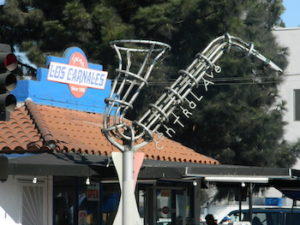
*Central Avenue in Los Angeles is celebrated on this date in 1920. This street is a major north-south thoroughfare in the central portion of Los Angeles, California.
From 1920 to 1955, Central Avenue was the heart of the Black community in Los Angeles, with active rhythm and blues and jazz music scenes. Located just to the west of the Alameda Corridor, it runs south from the eastern end of the Los Angeles Civic Center down to the east side of California State University, Dominguez Hills, and terminating at East Del Amo Boulevard in Carson.
From north to south, Central Avenue passes through Downtown Los Angeles, the areas of South Los Angeles, the city of Compton, and the city of Carson, which is part of the 17-city South Bay area of Los Angeles County. Central Avenue had two all-black fire stations. Fire Station No. 30 and Fire Station No. 14 were segregated in 1924. They remained segregated until 1956. The listing on the National Register says, "All-black fire stations were simultaneous representations of racial segregation and sources of community pride."
Local celebrities included Eric Dolphy, Art Pepper, Chico Hamilton, Clora Bryant, and Charles Mingus. Other jazz and R&B musicians associated with Central Avenue in LA include Benny Carter, Buddy Collette, Dexter Gordon, Lionel Hampton, Hampton Hawes, Big Jay McNeely, Johnny Otis, Shifty Henry, Charlie Parker (briefly), Gerald Wilson, and Anthony Ortega, Onzy Matthews, and Teddy Wilson. On its historical prominence, Wynton Marsalis once remarked, "Central Avenue was the 52nd Street of Los Angeles." From 1945 to 1958, Leon Hefflin Sr. produced the "Cavalcade of Jazz," held at Wrigley Field on 42nd in Los Angeles.
This part of the Central Ave Jazz Scene showcased over 125 artists in that timeline. The Cavalcade of Jazz concerts was the stepping stone to success for such stars as Toni Harper, Dinah Washington, Roy Milton, Frankie Lane, and others. He also hosted a beauty contest at the events. His first COJ show starred Count Basie, The Honey Drippers, Valaida Snow, Big Joe Turner, The Peters Sisters, Slime and Bam, and more artists on September 23, 1945, with a crowd of 15,000.
Jefferson High School, southeast of Downtown Los Angeles, was a school in the Central Avenue community that nurtured affluent Jazz students. These students, who would later establish themselves as either jazz/blues artists or singers, would follow a robust music curriculum. Nightclubs became the physical manifestation of jazz music along Central Avenue from Little Tokyo to Watts. The school produced many prominent musicians, including Etta James, Curtis Williams, Big Jay McNeely, and Richard Berry. Jefferson High School was a pivotal structure for a newly established Black district after the turn of the 20th century.
In the same way, many know Harlem as a historically Black enclave, the area in and around Central Ave was ironically referred to as "Little Harlem" due to its striking similarities. Harlem's Apollo Theatre and its importance to the neighborhood can be taken by the same token, referring to the many jazz clubs on Central Ave. However, in this case, looking at the ethnographical nature of Central Ave and its establishment of a jazz scene and culture, Jefferson High School's contribution cannot be overstated. Such an institution nurtured students, musicians, and athletes, sparking an inevitable culture of Jazz within.
Lionel Hampton composed and performed a tune called "Central Avenue Breakdown ."Dave Alvin's tribute to Big Joe Turner, "The Boss of the Blues," describes a drive down Central Avenue and Turner's reminiscences about the scene. Hampton performed for the 2nd, 5th, 6th, 7th, and 11th Cavalcade of Jazz concerts. The crowning of the first Cavalcade of Jazz Queen was postponed due to a showdown between Big Joe Turner and Lionel Hampton's band at the 5th concert. The crowd started throwing pillows, programs, and bottles into the field as the band paraded back to the stage. Central Ave paved the way for many historical happenings in Los Angeles.
From 1920, when the jazz scene on Central began to swing up to around 1955, it was the heart of the Black community in Los Angeles. Although Central Avenue is no longer the thriving jazz center it was, its legacy is preserved by the Central Avenue Jazz Festival and many jazz clubs, including Bluewhale in Little Tokyo. In 2014, rapper Bones named the song "CentralAve" on his album "Rotten."